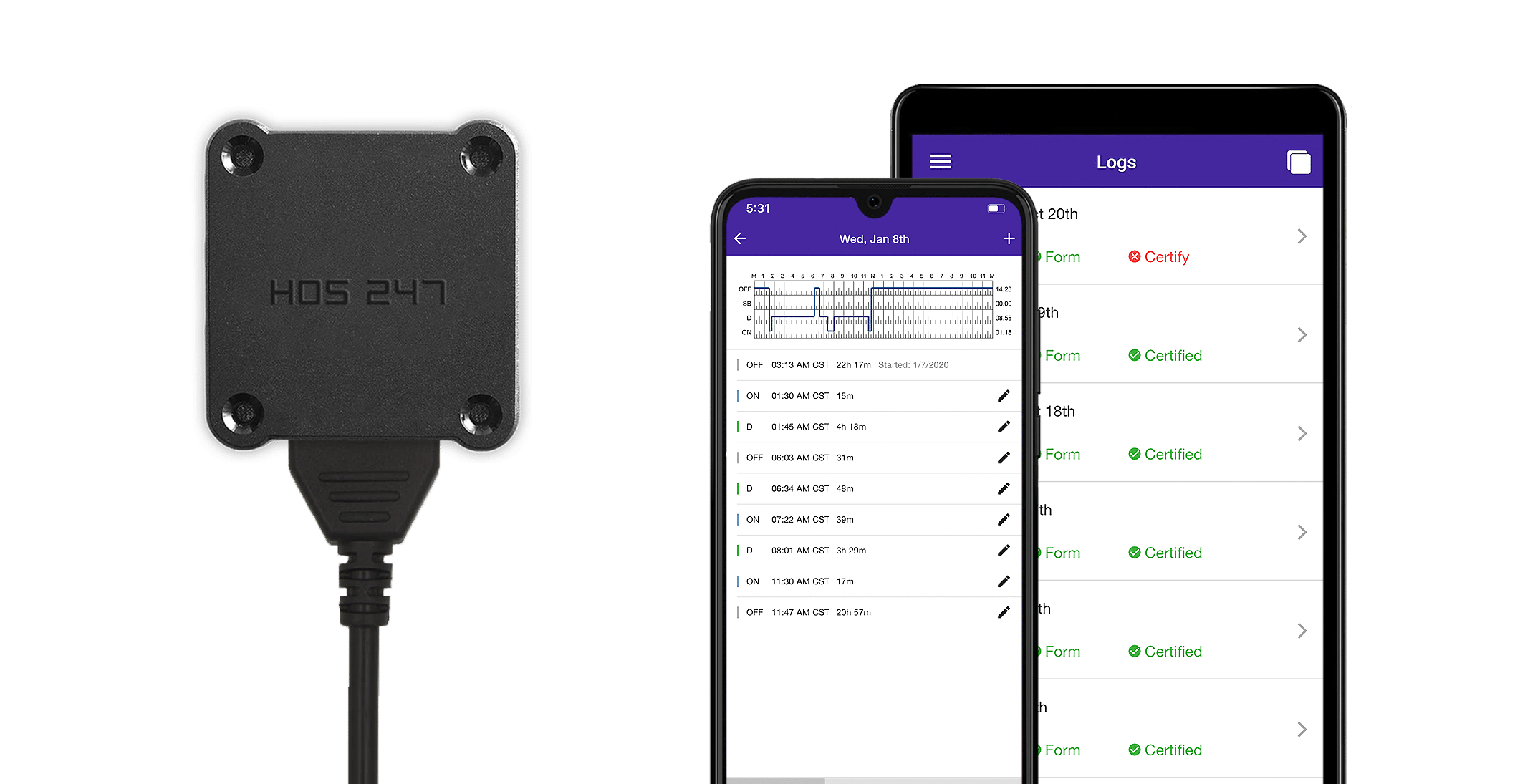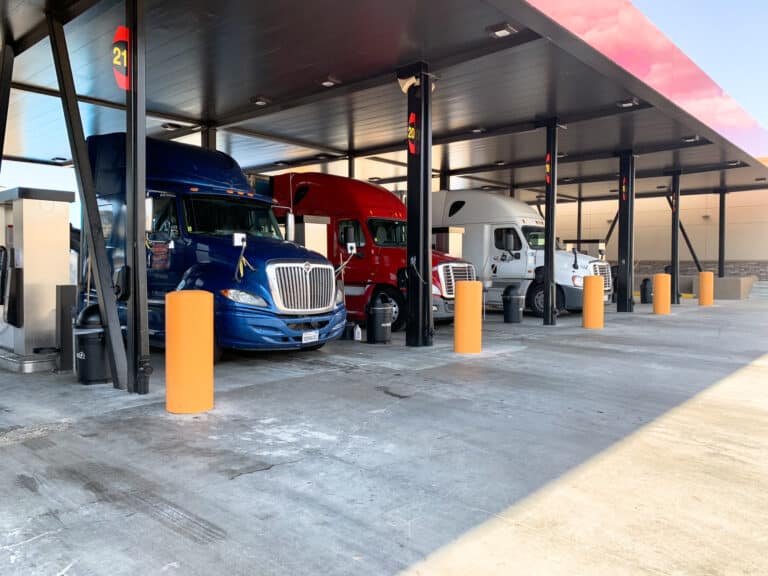Understanding hours of service isn’t just about staying compliant, it’s about maximizing your earning potential while keeping yourself safe out there. Every kilometre you drive, every load you haul, and every paycheck you earn comes down to how well you handle the hours of service (HOS) rules.
Here’s the reality: HOS violations can seriously damage your career. We’re not talking just about fines — though those hurt plenty. You could get put out of service, damage your National Safety Code (NSC) profile, and lose access to good-paying runs. But here’s what most drivers don’t realize: the operators who really know the truck driver hours law inside and out are the ones making better money. They plan smarter routes, waste less time, and actually get more done within the legal limits.
This guide breaks down everything you need to know about HOS rules in 2025. We’ll cover the five main rules that control your workday, the exceptions that can help you when things go sideways, and how a good electronic logging device (ELD) — certified by Transport Canada — can actually make your life easier instead of harder.
Whether you’re fresh out of driving school or you’ve been rolling for years, mastering these rules and getting the right electronic logbook can mean the difference between scraping by and building a real career in trucking.
Do you have any questions? Talk to ELD Advisor: 650-405-3372 or Request Callback
What Are Hours of Service Rules?
Hours of service rules tell you how long you can work and drive before federal regulations require you to rest. Bottom line: they exist because fatigued drivers cause accidents. The government has the statistics to prove it, and they’re serious about enforcement.
In Canada, HOS enforcement falls under the National Safety Code (NSC), specifically Standard 9, and is carried out by provincial and territorial authorities. Their job is keeping exhausted drivers off the road, and since certified electronic logging devices became mandatory, they’ve gotten much better at catching violations. The data shows it’s working: fewer HOS violations mean fewer crashes.
If you drive a commercial vehicle with a gross vehicle weight rating (GVWR) over 4,500 kg (about 10,000 pounds), and you operate extra-provincially — meaning across provincial or national borders — these rules apply to you. That includes long-haul, regional, and some local drivers depending on what you’re hauling. Some provinces have slightly different rules for drivers who operate only within a single province, but extra-provincial carriers follow the federal standard.
The Legal Framework
HOS regulations in Canada are established under the Commercial Vehicle Drivers Hours of Service Regulations, which fall under the Motor Vehicle Transport Act. This comprehensive framework covers how long you can drive, when you have to rest, and what happens if you violate the rules.
The federal law for truck driver hours sets the baseline for all extra-provincial carriers. Provinces can apply additional restrictions for intra-provincial carriers. But if you cross provincial or international borders, you’re playing by the federal rules — no exceptions.
Get caught violating HOS? You’re looking at fines that can range from hundreds to several thousand dollars per violation, depending on the province and severity. Multiple violations of the Canadian HOS regulations can get you placed out of service until the issue is resolved. And every violation can impact your carrier profile under the NSC, affecting your insurance, audits, and job opportunities.
The major change came in 2020 when Transport Canada made ELDs mandatory for federally regulated carriers, with a phased-in enforcement approach that fully kicked in by 2023. Understanding these regulations and how they’re enforced can help you work more efficiently in 2025.

The Five Core HOS Rules Every Trucker Must Know
Rule #1: The 13-Hour Driving Limit
This one’s straightforward: you get 13 hours of driving time, then you’re done until you take 8 hours off. No exceptions, no “just five more minutes to get to the truck stop.” Thirteen hours means thirteen hours.
“Driving” means you’re behind the wheel with the truck moving. Loading, unloading, pre-trip inspections, waiting at customers — none of that counts as driving time. But once you hit 13 hours of actual driving, you’re legally required to shut down.
Don’t try to push it. Even one minute over 13 hours is a violation, and enforcement officers have zero tolerance for this. Smart drivers set their ELD to warn them at 12.5 hours so they have time to find a safe place to park.
The key is planning ahead. Know your route, figure out where traffic gets heavy, and plan your fuel stops around your break times. Once you hit that 13-hour limit, your driving day is over whether you’re five kilometres from home or 500.
Rule #2: The 14-Hour On-Duty Limit
Here’s where it gets complex. You have 14 hours of on-duty time per day, including that 13 hours of driving. Unlike in the U.S., this on-duty window in Canada is not consecutive — the clock pauses whenever you’re off-duty for 30 minutes or more.
That gives you a bit more flexibility, but everything else counts: loading, waiting, inspections, fueling, etc. From the time you go on-duty until you go off, you’re burning that 14-hour limit — unless you’re off-duty long enough to pause the clock.
This is where experienced drivers separate themselves from the rest. Don’t start your on-duty time until you’re actually ready to work. If your load doesn’t pick up until 10 AM, don’t log on-duty at 6 AM just to pass time. Plan your day to minimize waiting around, and always have a backup plan when customers run late.
Treat those 14 hours like they’re valuable, because they are. Once they’re gone, you’re done driving until you take a full 8-hour break.

Rule #3: The 30-Minute Break
After 8 hours of on-duty time, you need to take at least 30 minutes off before continuing. This break must be logged as off-duty or sleeper berth — no exceptions.
This is a little stricter than in the U.S., where on-duty not driving can count. In Canada, it has to be off-duty time, and it has to be 30 consecutive minutes. That means no quick fuel stops or dock time — it’s got to be real downtime.
Plan your break strategically. Don’t wait until you hit exactly eight hours of on-duty time. Work it around fuel stops, meals, or long waits at customers. The smart move? Take your break while you’re already stopped, so it doesn’t eat into your day unnecessarily.
The biggest mistake? Forgetting about it completely. Quality ELDs will warn you when you’re getting close, but you should already know when and where you’re taking that break before you even start driving.
Rule #4: Weekly Limits (70/120-Hour Rules)
You’re limited to 70 hours on-duty in 7 consecutive days or 120 hours in 14 consecutive days, depending on your chosen cycle.
Unlike in the US, where it depends on carrier operations, Canada uses Cycle 1 (70/7) and Cycle 2 (120/14). You can switch between them if you do a proper reset (see next rule). Your available hours roll forward daily, so what you did seven or 14 days ago affects how much you can work today.
Smart drivers track their hours and plan lighter days when approaching the limit. Once you hit it, you’re done driving until you either get hours back or take the required reset.
Rule #5: The Cycle Reset (36 or 72-Hour Restart)
The reset lets you wipe the slate clean. If you’re on Cycle 1, take 36 consecutive hours off-duty. On Cycle 2? You need 72 consecutive hours off. Once that’s done, your hour count resets to zero and you can restart the cycle.
Strategic restart timing can boost your earning potential. Starting Monday with full hours available often means better load opportunities and higher pay rates than limping through the week with limited hours.
A Note on Driving North of 60: If you’re operating in the Yukon, Northwest Territories, Nunavut, or areas above the 60th parallel, different rules apply. You’re allowed up to 15 hours of driving, 20 hours on-duty, and only 8 hours off-duty per day. These rules reflect unique conditions in northern regions — but they only apply if your entire trip stays north of the 60th parallel. Once you cross south, regular HOS rules kick back in.
HOS Compliance and the ELD Mandate
Since January 2023, most commercial drivers in Canada have been required to use electronic logging devices instead of paper logs to track their hours of service. The ELD mandate applies to drivers who are required to maintain records of duty status (RODS) and operate vehicles manufactured after 2000.
Transport Canada maintains a list of registered electronic logging systems that have been self-certified by manufacturers as compliant with Canadian HOS regulations. However, being on this list doesn’t guarantee an electronic logbook actually meets all requirements — it just means the manufacturer claims it does. This is why choosing a reputable ELD provider with proven reliability is crucial.
Key exemptions include drivers using vehicles with engines manufactured before 2000 and those who qualify for the short-haul exception. However, many exempt drivers choose to use electronic logs anyway because of the operational benefits they provide beyond basic compliance.
Penalties for ELD violations can be severe, including fines up to $5,000 CAD for drivers and carriers who fail to use compliant devices. During inspections, officers can also place drivers out of service for these violations, meaning no driving until the problem is resolved.
How ELDs Ensure Compliance
Modern ELDs automatically track your driving time by connecting directly to your vehicle’s engine control module (ECM). This connection eliminates the possibility of “forgetting” to log driving time or accidentally miscalculating your hours — the system records everything automatically.
Real-time violation alerts are one of the biggest advantages of quality ELD systems. Instead of discovering you’re in violation during a roadside inspection, good electronic logbooks warn you before you exceed legal limits. These alerts give you time to find safe parking or adjust your plans before breaking HOS rules.
The systems also maintain detailed records that are easily accessible during inspections by enforcement officers. Officers can review your logs electronically without requiring you to fax or email anything, which streamlines the inspection process and reduces the chance of paperwork-related violations.
Common ELD Challenges Truckers Face
Not all ELDs are created equal, and many drivers struggle with systems that create more problems than they solve. Poor user interface design tops the list of complaints — systems that require multiple taps for basic functions or use confusing menu structures can actually distract drivers and make compliance harder.
Hardware reliability issues cause major headaches on the road. Electronic logbooks that frequently lose connection to your vehicle’s ECM, have weak wireless signals, or fail during critical moments can leave you unable to log required information. The most frustrating problems include:
- Connection failures during inspections when you need to show your logs.
- System crashes that lose hours of recorded data.
- Poor GPS accuracy that shows incorrect locations during violations.
- Battery drain that kills your device when you need it most.
Customer support becomes critical when technical problems arise, but many ELD providers fall short here. Limited support hours, long hold times, or representatives who don’t understand trucking operations can leave you stranded when you need help most. The best providers offer support every day by knowledgeable staff who understand the urgency of compliance issues.
Why Truckers Choose HOS247 for ELD Compliance
Professional drivers in Canada count on HOS247 for an ELD solution that delivers consistent performance without the frustrations of unreliable systems. From hardware durability to customer support, HOS247 is built to make compliance easier and operations smoother.
- Reliable connection. Our ELD maintains a stable wireless link to your vehicle’s ECM, reducing disconnections that cause logging errors and delays during inspections.
- Quick, plug-and-play installation. Set up takes just minutes. The device works with all vehicle types and engine years covered under the Canadian mandate — no compatibility worries.
- Top-rated mobile app. Designed with driver input, the HOS247 app is intuitive and responsive, earning high ratings in the Apple App Store and Google Play for ease of use and performance.
- Multilingual customer support. Reach real people seven days a week in English, Spanish, Russian, or Polish. And if a support call drops, we call you back.
- Built-in GPS tracking. Track vehicle location in real time with our GPS feature to optimize routes and improve dispatch efficiency. Visibility into fleet activity helps reduce downtime and fuel costs.
- IFTA calculations. The system automatically tracks distance by province, simplifying quarterly IFTA filings and reducing the risk of costly errors.
- No long-term contracts. Choose a month-to-month plan or save with an annual subscription. You’re not locked in — you can decide to stay because the system works, not because of a contract.
- Two-week risk-free trial. Try HOS247 with no pressure. If it doesn’t fit your needs, return it within two weeks for a full refund, no hassle.
- Free hardware with annual plans. Choose a yearly subscription and get the ELD device at no extra cost, making compliance more affordable from the start.
With HOS247, Canadian drivers get more than an ELD — they gain a dependable partner that supports their business with transparent pricing, real support, and tools designed to work the way truckers do.

Maximizing Your HOS Efficiency: Strategic Tips
Successful drivers don’t just follow the truck driver hours law — they use strategic planning to maximize productivity within legal limits. Pre-trip planning makes the difference between profitable runs and wasted time sitting in truck stops.
Route planning should always factor in HOS considerations. Know where traffic typically slows down, identify truck stops and rest areas along your route, and plan fuel stops that align with your mandatory break requirements. Smart drivers also research customer locations ahead of time to avoid getting stuck in areas with limited parking when their hours run out.
Load timing and delivery window management require honest communication with dispatchers and customers. Don’t accept impossible schedules that force you to choose between HOS violations and on-time delivery. Build buffer time into your schedule for unexpected delays, and always have backup parking options when delivery appointments run late.
Technology integration beyond basic ELD compliance can significantly improve your efficiency:
- GPS tracking data helps dispatchers make better load assignments based on your location.
- Vehicle diagnostic information allows proactive maintenance scheduling to prevent breakdowns.
- Fuel efficiency monitoring identifies driving habits that waste money.
- Performance analytics show patterns that help optimize your weekly schedules.
The most successful drivers also set personal alerts before reaching legal limits. Instead of waiting for the ELD to warn you at exactly 13 hours, set your own alert at 12.5 hours. This gives you time to find safe, convenient parking rather than scrambling for the nearest truck stop.

Common Violations and How to Avoid Them
Understanding the most frequent HOS violations helps you avoid costly mistakes that can damage your career and earning potential. The top violations happen when drivers misunderstand the rules or try to push legal limits too far.
Driving beyond the 13-hour limit is the most common violation, often happening when drivers misjudge travel time or get caught in unexpected traffic. The solution is conservative planning — always assume traffic will be worse than expected and build extra time into your schedule. Remember, even one minute over 13 hours counts as a violation.
Operating past the 14-hour on-duty window catches many drivers off guard because they don’t account for loading delays or customer wait times. Start your on-duty clock as late as possible, communicate realistic delivery times with customers, and have parking backup plans ready when appointments run long.
Missing or taking inadequate 30-minute breaks happens when drivers forget about the requirement or try to shortcut it. Canadian rules require a 30-minute break after 5 hours of driving, which can be taken as off-duty, sleeper berth, or on-duty not driving time. Plan these breaks around natural stopping points like fuel, food, or loading activities.
Weekly hour limit violations often result from poor record keeping or misunderstanding how the weekly limits work. Use your ELD’s weekly summary features to monitor your total hours, and plan 36-hour restarts strategically to reset your weekly clock when needed.
Prevention strategies focus on building good habits and using technology effectively:
- Daily planning sessions before starting your drive to review hours available and route challenges.
- Regular ELD monitoring throughout the day to track remaining time.
- Communication protocols with dispatch about realistic scheduling and potential delays.
- Emergency procedures for handling unexpected situations that threaten compliance.
The best drivers treat HOS compliance as a competitive advantage rather than a burden. They understand that consistent compliance leads to better NSC scores, lower insurance costs, and access to higher-paying loads that companies reserve for their most reliable drivers.
Future of Truck Driver Hours Law
The trucking industry keeps pushing for more flexibility in HOS rules, but don’t hold your breath waiting for major changes. The federal government moves slowly on these things, and safety always comes first in their decisions.
Recent discussions focus on expanding split sleeper berth options and adding exemptions for specific types of hauling. Technology trends suggest future rules might include fatigue detection systems and advanced driver monitoring beyond basic electronic logging devices.
Here’s the reality: if ELD data shows fewer accidents, regulators might consider more flexibility. If safety improvements stall or violations increase, expect tighter enforcement instead of looser rules. Transport Canada bases everything on hard safety data, not industry complaints about inconvenience.
Don’t plan your career around changes to the laws for truck driver hours that may never happen. Work within current regulations and adapt when official changes actually occur.
Staying Current with Regulations
Stay informed through reliable sources like the Transport Canada website, industry publications such as Truck News and Today’s Trucking, and professional trucking associations like the Canadian Trucking Alliance. Many provincial trucking associations also provide updates on both federal and provincial regulations.
While quality ELD providers often communicate important regulatory changes that affect their devices, you’re ultimately responsible for staying current with HOS rules. Transport Canada encourages drivers and carriers to subscribe to updates and safety notices regarding electronic logging and hours of service regulations.
Don’t rely on truck stop rumors or social media for regulatory information. When HOS rules change, you need accurate information from official sources, not secondhand speculation that could get you in trouble.

Conclusion
HOS compliance isn’t negotiable if you want to succeed in trucking. Every violation hits your wallet through fines, damages your safety rating, and costs you access to better-paying loads. But here’s what most drivers miss: operators who really understand these rules turn HOS knowledge into a competitive advantage.
The five core rules control every aspect of your workday, from daily productivity to long-term earning potential. Mastering exceptions and special circumstances can save your career when unexpected situations arise. Most importantly, the right ELD system transforms compliance from a constant headache into a tool that actually helps your business.
Don’t let poor ELD technology or gaps in HOS knowledge limit your earning potential. Master the rules, get the right tools, and build the profitable trucking career you deserve. Try HOS247 today and see how the right electronic logbook works for you instead of against you.
Important notice: This article provides general information about Transport Canada Hours of Service regulations as of June 2025. Regulations may change, and specific situations may have different requirements. Always consult current Transport Canada regulations and your safety department for guidance specific to your operation. This information is for educational purposes only and should not be construed as legal advice.

As an expert in B2B and B2C sales, I’ve dedicated myself to perfecting sales processes and client retention strategies in the logistics and trucking industry. I have significantly contributed to the expansion of the ELD service, catering to retail and wholesale clients in need of HOS247 ELD solutions. My unwavering commitment to implementing state-of-the-art sales techniques and technologies ensures the continuous growth and success of businesses I work with.












GPS tracking is an indispensable tool for fleet businesses as it provides managers with information about the real-time location of vehicles and other assets, helping motor carriers effectively monitor their fleets and optimize processes. Canadian truck fleet tracking uses Global

Electronic logging devices (ELDs) have revolutionized the trucking industry, providing a more accurate, efficient, and secure way for truckers to record their hours of service (HOS) and ensure compliance with federal regulations. Transport Canada mandates the use of ELDs for

The Canadian ELD mandate final compliance phase is now almost in effect, but many trucking companies are stuck with outdated legacy providers and still have yet to make a move on the right compliance partner. They may not know whether